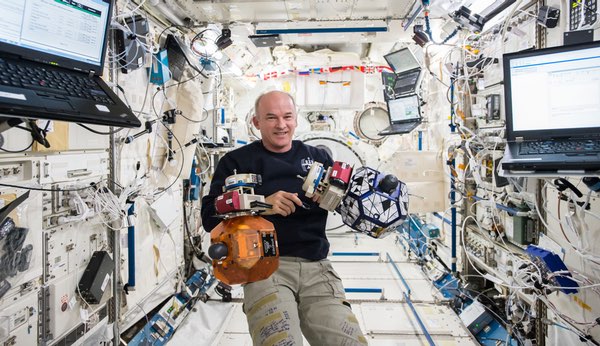Microbench researchby Philip Backman
|
| The almost perpetual microgravity myth, however, for all places beyond Earth (I have talked to people who are surprised to learn the Moon has gravity) has the potential to obscure the realty of space and what it can offer us. |
Cuarón and Bullock, of course, articulated the common and erroneous explanation that there is no gravity in space, or at best only microgravity. But with the movie set in low Earth orbit, about 350 kilometers above the Earth’s surface, there is nothing zero or micro about gravity. To quantify it, the gravitational force acting on an astronaut in the movie, 350 kilometers up, is reduced 10 percent from the gravitational force she experiences when training at the earth’s surface. That’s not much of a difference—certainly not “micro-g.”
Obviously, the history behind the erroneous explanation is linked to the thought experiment of what would happen to each of us down here on Earth if gravity suddenly vanished. What we picture in our mind looks an awful lot like the images of astronauts in spacecraft. The microgravity explanation seems correct on a visceral level, is easily comprehended, and, most importantly, gives space an exotic coloring. The almost perpetual microgravity myth, however, for all places beyond Earth (I have talked to people who are surprised to learn the Moon has gravity) has the potential to obscure the realty of space and what it can offer us.
To back up briefly: if not a lack of gravity, what then is going on? Why do astronauts on the International Space Station (ISS) have such freedom of flight? An afternoon with a university physics textbook begins to work away at the confusion, and I will leave many of the details for you to discover. However, in my own explorations on this topic, one observation in particular stood out, which has since helped me place, in particular, microgravity research in context. The observation is this: when on orbit there actually is a force which has gone to zero (or micro) relative to what is experienced on earth, it just is not the gravitational force. It is the bench force that has gone to near zero!
By “bench force,” I mean the support force that holds us up on Earth. If you are sitting down as you read this, the bench force is the chair you’re sitting on. Remove the chair and what happens? You fall to the floor. Where is your coffee mug? Sitting over there on a table. Remove the table and down comes the coffee mug—falling till it hits the floor. In both cases the bench force has been removed. When the bench force is present, it pushes up in equal opposition to the gravitational force pushing down. Remove the bench force and all you have is gravity pushing down, and indeed things head downward rapidly before crashing into the next “bench.” It is during this brief period of falling—from bench to floor—that the miss-identified microgravity experience occurs. Falling is what we perceive as microgravity.
Given that the support force is the thing greatly reduced or even brought to zero, the correct descriptive language is not microgravity, but microbench. Falling is a microbench force environment!
| The thing about research is that you do not know where it will lead. But we do know that the first 45 years of microbench research has been less than spectacular. |
Now here on earth our experience with microbench force is limited. Even for a long fall that can hurt us we are in it for only seconds at most; not much time to enjoy the experience before the ambulance ride. And for truly great and deadly falls near the Earth’s surface, air resistance causes the bench-to-floor fall to deviate from pure freefall. However, on orbit, a spacecraft falls continuously because it sits on nothing. No bench force. Inside the spacecraft the astronauts, their equipment, their food, supplies—all of it—is falling too. No bench force! Even if the spacecraft includes a bench there is no bench force because the bench itself is falling as it is attached to a falling spacecraft.
Some may find this view comical, or maybe just semantical. I find it helps me think clearly about, in particular, microgravity (microbench!) research. When I think or read about a potential microgravity experiment I ask myself, “If I complete the experiment on a bench, should I expect different results if I next conduct the exact experiment while it falls (entering a microbench environment) from the bench to the floor? Will removing the bench make a difference?” Maybe it will make a difference, but maybe not. Viewed in terms of a microbench force, space (particularly near Earth space) certainly becomes less exotic. It tempers down some of the “Gee whiz, what if I do my experiment in space!” reactions.
As an example, I once read about fire resistant materials being tested on board the space station. Would I expect fire resistant material to act differently while falling from the bench verses sitting on the bench? At first thought, fire resistance doesn’t seem to be a property that would significantly be influenced by removal of the bench. I’m doubtful.
As this publication noted, “What’s missing, many argue, is a long-desired ‘killer app’ for commercial LEO research, something so compelling that it will open the floodgates and generate enough demand to sustain perhaps multiple commercial facilities in orbit.” (See “The challenges of commercializing research in low Earth orbit”, The Space Review, April 4, 2016.) This quote gives a decent summary of where microgravity research sits after 45 years of investigation. And the thing about research is that you do not know where it will lead. But we do know that the first 45 years of microbench research has been less than spectacular.
